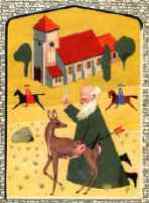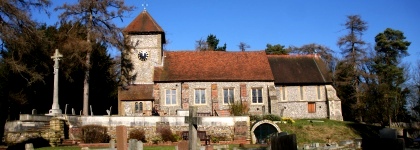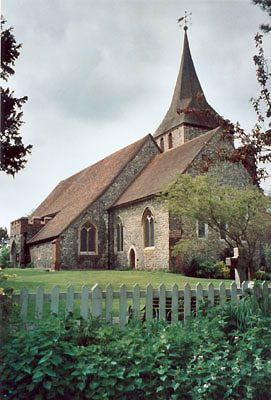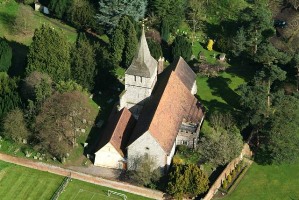


CHELSFIELD WITH FARNBOROUGH PARISH
In an Anglo-Saxon Charter of AD 862, Ethelbert, King of Wessex (see picture below) gave to his minister, Dryhtwald, ten hides of land, about 1200 acres, in Fearn Biorg,
The ‘The Domesday Monachorum’ is an ancient book in the archives of Canterbury Cathedral. It was compiled on the orders of Archbishop Lanfranc when he came into office in 1070.
Parishes with a resident priest were listed as Churches and those without a priest were listed as Chapels to the parish where the priest resided. ‘Faernberga’ paid 6d as ‘Chrisome fee’ as a Chapel to Chelsfield. Research has shown that the list in the Domesday Monachorum is a Saxon list, hurriedly found and copied out to meet the instructions of the Archbishop. (Many churches known to have existed in 1070 are missing). Farnborough Church existed before 1070, perhaps as a wooden structure (like Greenstead Ongar, in Essex), which had either fallen down or was considered of no value when the Domesday Survey was made in 1085
Bishop Gundulf became Bishop of Rochester in 1077 and he recorded in his Chronicle that he received the Tithes from both Chelsfield and Farnborough. He also recorded that Tithes had been bestowed on the Bishoprick by Arnulf of Chelsfield, who appears in the Domesday Book of 1085 as Arnulf of Hesdin, Lord of the Manors of Chelsfield and Farnborough
In 1085, the income of the Manor of Chelsfield was some twenty times larger than that of the Manor of Farnborough, so Arnulf would have made his headquarters at Chelsfield with his Priest residing there. Neither Chelsfield nor Farnborough are recorded as having a church in Domesday times.
It is recorded in Bishop Courteneye’s register
of 1385 that John de Dountone was Rector of Farnborough only, an
occurrence which did not happen again until John Montague was ‘put
in [as Rector of Farnborough] by parliament’ during the Commonwealth
period in 1650.
King Henry’s introduction of Parish Registers
caused alarm at first as people thought it was being done to produce
a Taxation Register, but it was his son Edward VI who ordered an
inventory of the goods in each parish to be made every three years.
In 1552, the Churchwardens, John Lambe & John Marshall, ‘of the
parishe Church of Farneborowe’ showed to the King's inspectors, one
Communion Cup, a Brass Cross, two Copes, two altar frontals, a large
Bible and a book of Erasmus. They also showed them three bells in
the steeple. The inspectors gave them a clean sheet, certified that
they had no ‘Popish’ items in their charge and that they had not
illegally disposed of any of the church’s property. The local Rural
Dean carries on this type of survey annually to this day.
 St Martin of Tours, Chelsfield |
Farnborough’s original paper Register in which, apart
from the required entries, information was recorded of the
change of Kings and Rectors and other interesting facts, is
still in existence. The first entry of this kind is a change
of Rector, recorded in 1576 ‘Septembris 18, 1576, Gulielmo Gybbins, sepulto, Rector ecclesiae Chelsfield et Farnborough, cur. Successit Georgeius Smith, Artium Mr. Collegii Alsol. Oxon, socius 300 Aetatis do caturiae natus’. This states, in Latin, that in 1576 William Gibbins, the previous Rector had died and had been succeeded by George Smith, Master of Arts of All Souls, Oxford, aged 30 years. |
At this time, Farnborough Parish and Chelsfield Parish constituted a Combined Benefice, a long-standing arrangement which continued almost to the end of the 19th century. This meant that the revenues of both parishes were paid to the same priest, who was Rector of both Parishes, each having its own Registers, Churchwardens and Parish Officers. George Smith, named here in the Register, was the first of three generations to be Rector of both parishes, being succeeded by his son, George Smith II, and by his grandson, George Smith III, who died in 1650 during the time of the Commonwealth (1640-1660). On his death, Parliament installed John Montague as Rector of Farnborough and Robert Miller as Rector of Chelsfield. On Charles II’s Accession in 1660, all the Acts of the Commonwealth Parliaments were declared non existent and the two parishes once more became a combined benefice, with its previous patron, and Robert Miller became the Rector of both parishes.
As Farnborough was the poorer of the two parishes, the Rectors spent most of their time in Chelsfield, some having left not even a signature in the Parish Registers, the parish work being left to the Curate they had appointed. Thus it reveals that Robert Jegon, who was Curate for many years in the 18th century, recorded in the Parish Register that he had paid the Duty up to date to Thomas Jones, the official collector. This Duty was a Tax which in 1694, was 2 shillings for every birth registered, 4 shillings for each funeral and 2 shillings and 6 pence for each wedding, plus annual tax of 1 shilling on each bachelor and widow living in the parish. The Tax was simplified in 1794, with a charge of 3 pence for every entry in the Church Register.
|
|
Lord Hardwick’s Act of 1753 saw the introduction of an official book of marriage forms. Farnborough partially complied with the act but the existing Marriage Register was ruled up in the same way as the official forms, and continued to be used. The official book was obtained somewhat later than required. |
 Lord Hardwick |
The Rector at this time was Charles Meetkeirke who had been presented to the bishop by his cousin Adolphus Meetkerke, who had obtained the Avowson (the right to present a new Rector to the parish when the living became vacant) from Thomas Norton, Lord of the Manor of Chelsfield. The Avowson had been held with the Lordship of the Manor of Chelsfield since the time of the Norman Conquest. Charles Meetkerke was invested in 1751 and succeeded by Adolphus who, soon after, disposed of the right of presentation to All Soul’s College, Oxford, who were to provide future incumbents for some time. On his death in 1774, Charles Meetkerke chose to be buried in Farnborough rather than Chelsfield and he lies today in front of the Altar, facing his parishioners. His ledger stone reads:
‘Here lies Inter’d the Body of Charles Meetkerke, LL.B., rector of Chelsfield with Farnborough, and Died Lamented. The 11 day of February, 1774. In the 64th year of his age. Also the body of Ann, his wife, Daughter of William Mant, Gent., who Died the 25th Day of Novr., 1773, Aged 51 years.’
The building of the South Eastern Railway in 1868 positioned a new 'Chelsfield' station some distance from the village centre. Later in 1926 Orpington bypass opened, causing further fragmentation by separating church from village. Most recently, in 1938, further parts of both Chelsfield and Farnborough parishes were removed, in order to create the new parish of Green Street Green and Pratts Bottom.
Today Chelsfield Parish is less than one third of its original size.
The creation of the green belt after the second world war dictated that population growth in Chelsfield was going to be limited for the foreseeable future.
A full account can be found on the
Chelsfield Parish website

